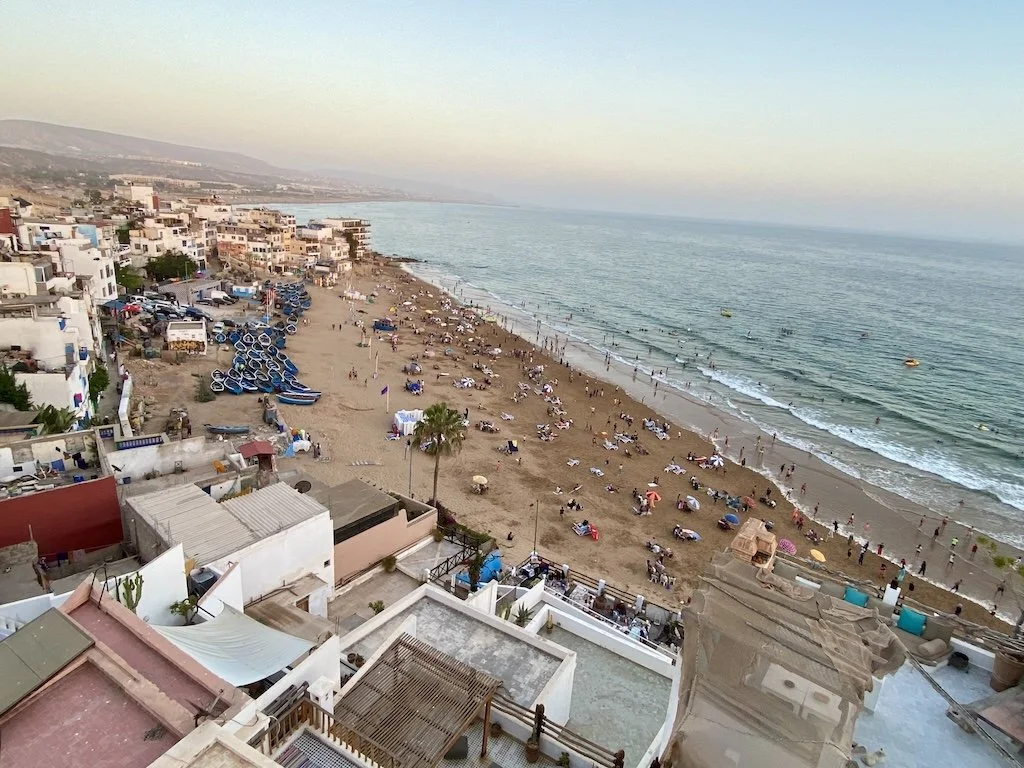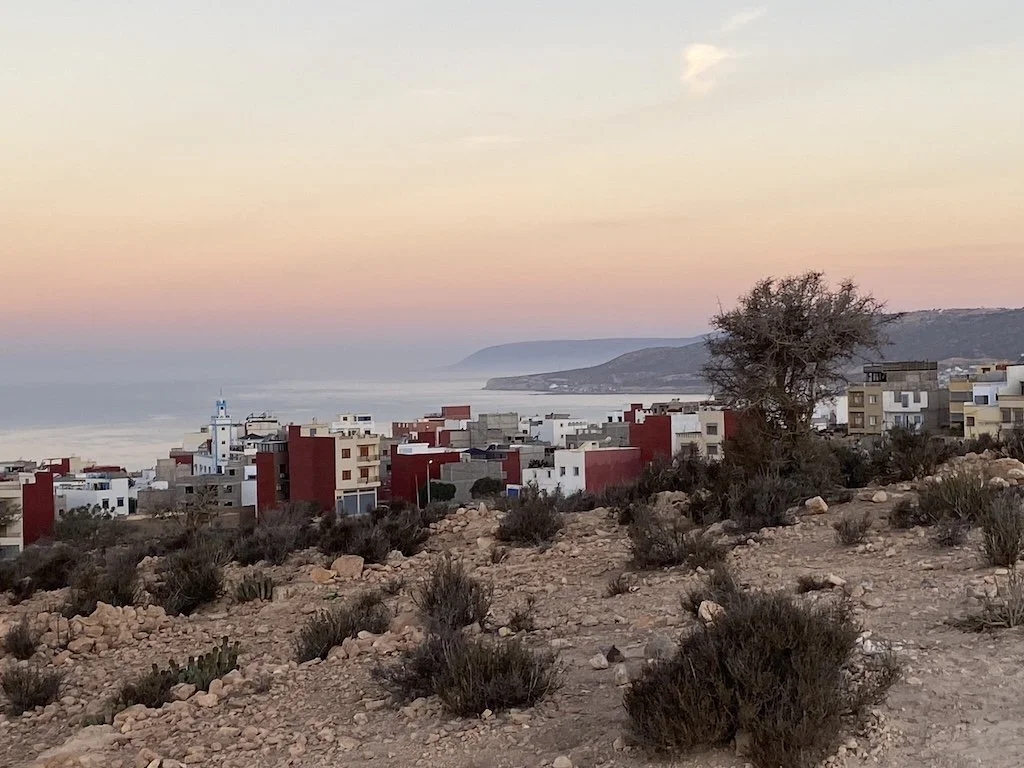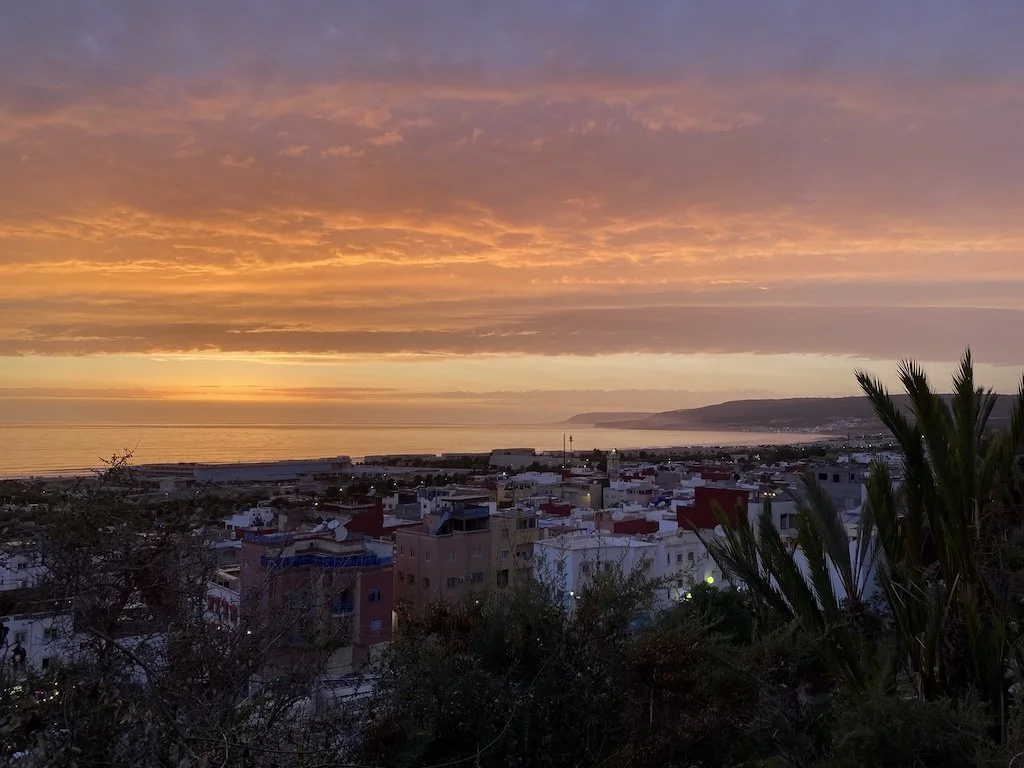Tamraght vs Taghazout: Which Surf Village Is Better for You?
If you’re dreaming of surfing Morocco’s south coast, you’ve probably come across two names again and again: Tamraght and Taghazout. These two Amazigh (Berber) fishing and surf villages, located to the north of Agadir, have grown rapidly into popular surf towns in southern Morocco and typically fall within the zone known as Taghazout Bay.
Close in location, 8km apart, they are two of the best surf villages in Morocco, with access to the same wave-rich coastline, and are brimming with everything to complete the surf lifestyle: surf shops, surf camps, yoga studios, hip cafés, skate parks, and surf schools. However, while similar in many ways, they are actually quite different.
Considering a surf trip to Tamraght or Taghazout, how do you choose? This blog will give you a feel for both, and then you can decide for yourself which is best suited to you and your fellow travellers.
Taghazout was the first to be discovered by surfers, and the popular surf camps in Taghazout, such as Surf Maroc and Amayour, were among the original establishments. As tourism developed, the neighbouring village of Tamraght caught up and continues to spread. Both share proud cultural Amazigh roots, a year-round warm climate, numerous surf spots, and a wide range of surf-friendly accommodations, from homestays to five-star resorts. Two roads connect Tamraght and Taghazout, and a well-paved and illuminated beachfront promenade, perfect for walks, jogs, and cycling.
Taghazout: The Original Surf Village
Taghazout is the more picturesque and well-known traditional fishing village, with colourful houses and narrow alleyways that lead down steep steps to a pretty sandy beach where you can watch the fishermen bringing in their daily catch. The village is right on the edge of the Atlantic, and a stay in Taghazout means you can sleep to the sound of the ocean, and are close, as in walking distance, to a handful of Taghazout surf spots, including Panoramas, Hash Point, La Source, Anchor Point, and Mysteries. In season, Taghazout gets busy, especially when there’s an event on, such as a World Surf League competition or the Taghazout Surf Expo. In the evenings, the popular restaurants along the waterfront will require a reservation or a wait. Taghazout is livelier than Tamraght at nighttime, in part because it has licensed premises that serve alcohol.
Best for: solo travelers staying in surf camps, couples who enjoy boutique hotels like Amouage or Munga Guesthouse, families with older kids, and surfers. Digital nomads will love co-working spaces like SunDesk. Taghazout is great for those who like a party scene.
My local opinion: I love visiting Taghazout to surf and for an evening out. To enjoy the oceanfront bars/ restaurants with sunset views. I would take a taxi these days as finding a parking space can take a while. To live, I find it too compact and crowded, with everything on top of each other, but I have a playful dog and a car. If you don’t drive, want nightlife, and to be within walking distance of beginner to advanced surfing spots, it’s a great option!
Taghazout beach view in Summer
Tamraght: The Laid-Back Alternative
At times, it feels like Tamraght is constantly ‘under construction’. New hotels, new roads, new roundabouts, new cafés, new everything, almost every week. If you like new openings, you’ll love Tamraght. If you like drilling and dust, even more so. However, even amidst all this development and buzz, there’s a way of being radiated by the Tamraght locals that encourages slowing down. Tamraght is home to many Amazigh families, as well as Moroccans from all over the country, many of whom come to work in the surf tourism industry. It also boasts a growing expat community, digital nomads, and holidaymakers who return again and again, most seeking a simple, slower life by the ocean. While most of the village is located away from the beach, a growing number of cafés, restaurants, and shacks on the beach offer coffee, brunch, fish/ seafood, and tagines.
One of the main differences between Tamraght and Taghazout is that 99% of the accommodation in Tamraght is at least a 10-minute walk from the surf, and if you’re staying in upper Tamraght, more like 20 minutes. This distance, combined with a board, wetsuit, and steep incline, can get tiring. If you plan to rent a car/bike or stay at a surf camp, that won’t matter, but if you want to surf independently without wheels, it's worth bearing in mind. The main surf spots in Tamraght are Devils Rock, Cro Cro, Banana Point, and Banana Beach.
Best for: solo travelers staying in one of Tamraght’s many surf camps. Couples can enjoy luxury hotels like Fairmont Taghazout Bay. Families with young children can rent self-catering apartments, such as La Petite Palmeraie, or enjoy the best of both worlds by booking an apartment within a surf camp, like Surf + Friends Lodge. Independent surfers and digital nomads seeking longer stays are well catered to, with long-stay co-living and apartment rentals available, such as Kasbari. Tamraght is great if you like a friendly, community scene.
My local opinion: There’s a reason I chose to live in Tamraght; it’s quieter, feels more residential and spacious, and it’s actually comprised of numerous small villages that begin at the main road and ascend a steep hill. That said, it’s still easy to explore on foot or by bike, even if some roads are bumpy. Tamraght boasts a surprising number of excellent cafés and community hubs, such as Hey Yallah, Nafas, and Daydream, that cater well to the large volume of digital nomads in Tamraght during Morocco’s peak surf season, October to April. During this season, you can enjoy a variety of activities, including running clubs, yoga spaces, women-only indoor and outdoor gym classes, and creative workshops.
Tamraght village view from the hill
Best time to visit
Taghazout and Tamraght are year-round holiday and ocean living destinations, depending on the kind of holiday or lifestyle you are looking for.
For surfers, the most consistent and powerful Atlantic swells roll in from December to March, a great time for intermediate and advanced surfers. If you are a beginner, this Winter season can be a fun time to mess around in white water, and there are times when the swell drops. Bring a 4/3 or 3/2 wetsuit as the water gets cold. The air temperature stays mild during the daytime, but at night and early mornings, it can hover around 10°s.
From April to June and September to November; waves are less powerful, the ocean is warmer, and you’ll find more beginner-friendly green waves.
July and August are the peak Summer months; the villages become crowded with Moroccan tourists, both from within Morocco and Moroccans who live abroad, coming to spend time with their families. During the Summer months, it can be very hot, mid 30°s to early 40°s, and the beaches and roads are packed. There is also a sea fog that comes in the mornings; it usually burns off by midday, but sometimes it sets in. Honestly, if you live here, you’ll be glad of the cloud cover! The drive from Tamraght to Taghazout usually takes 15 minutes, but can take up to 2 hours. Parking can be a challenge. The ocean heats up, and the waves drop; it’s a nice time for swimming, paddleboarding, and occasionally catching baby waves.
Getting There and Around
One of the most surf-friendly options is the Souk to Surf shuttle; check their timetable and prices here.
The closest airport to both Taghazout and Tamraght is Agadir. From Agadir airport, it’s around a 50-minute drive to Tamraght and a 60-minute drive to Taghazout on a new road that bypasses Agadir city centre. You can arrange a taxi upon arrival or pre-book a transfer through your accommodation; expect to pay around MAD300 each way, depending on your group size and luggage. There are also several car rental agencies based in the airport terminal.
There is an airport shuttle to Agadir city centre; however, from there, it is another taxi or bus ride to Tamraght or Taghazout. Honestly, it's better to take a taxi directly from the airport to Tamraght or Taghazout.
If you are arriving at Agadir bus station on CTM or Supratours. You will find Grand Taxis waiting by the exit. Expect to pay MAD150-250 (to Taghazout), MAD100-150 (to Tamraght), depending on time of day, your location, and bargaining skills. Agree on the price before you get in.
Which One Should You Choose?
When weighing the options between a stay in Tamraght vs. Taghazout, decide on your priorities and preferred vibe. Travelling between Tamraght and Taghazout is easy by local ALSA buses, a taxi, or cycling or walking along the beachfront promenade, approximately 6 kilometres each way. What makes it special is that there is something for everyone. And a little PS. from someone who has resided in the area since 2018, your experience will be remarkably improved if you make a little effort to understand the local culture and way of life.
Choose Tamraght if you want: space, calm, community, and a more local feel.
Choose Taghazout if you want: cobbled street charm, surf-on-your-doorstep convenience, and buzzy nightlife.
Thank you so much for reading! If you found it useful, please share it with your friends and followers. If you’d like more help planning a trip, I offer a travel planning service.
Taghazout Bay sunset, Tamraght in foreground and Taghazout in the distance





